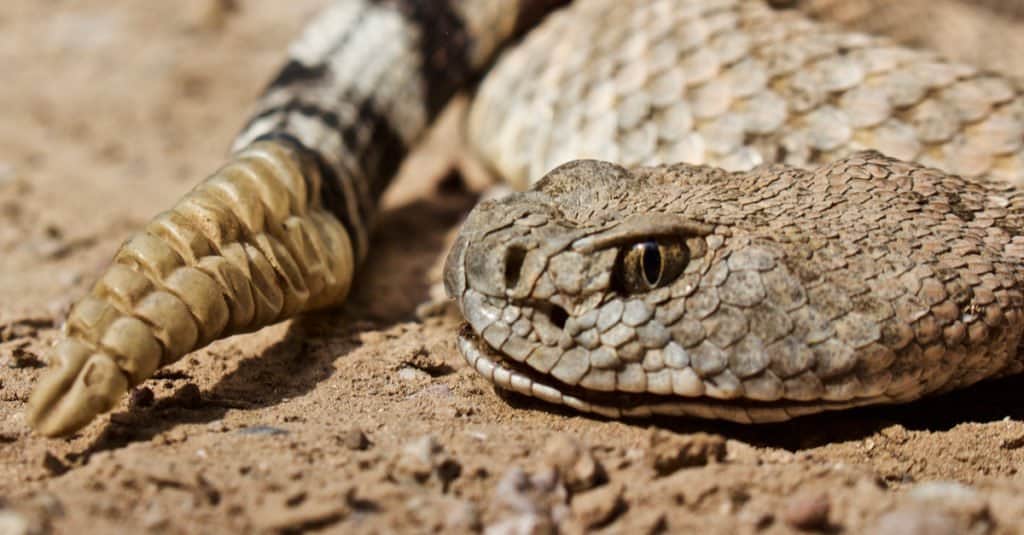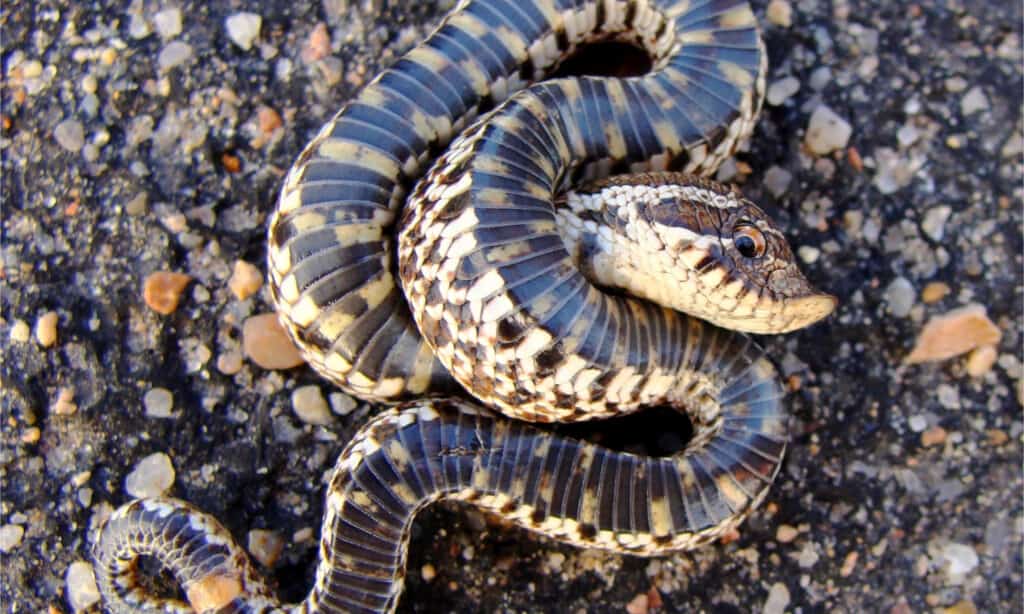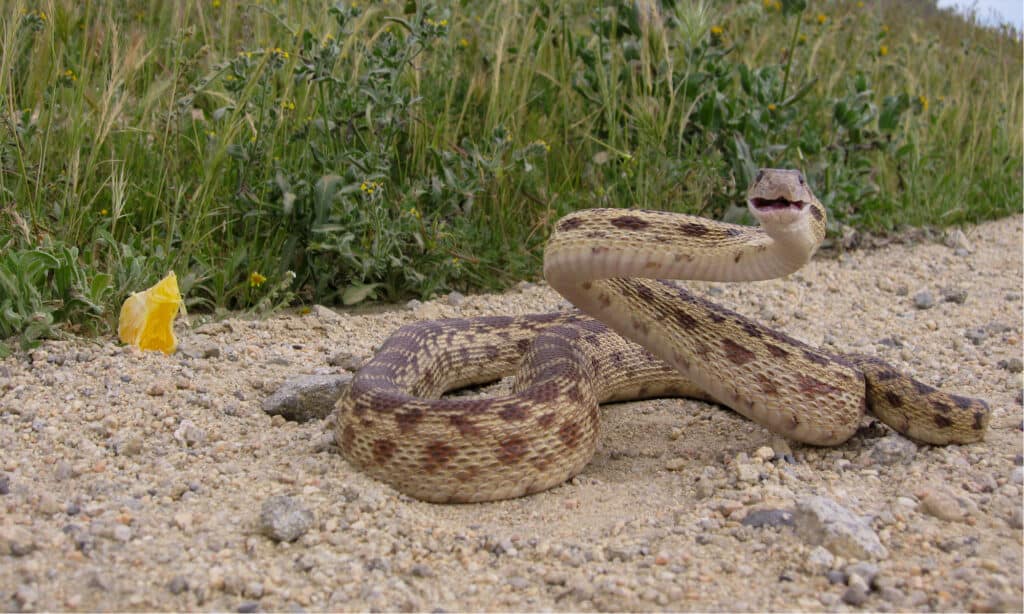The list of the top largest (and most dangerous) snakes in Montana is a short one because the western/prairie rattlesnake is the only venomous snake in the state. However, Montana is also home to quite a few large snake species that are plenty interesting all on their own!
Montana Is a state that is overflowing with pure natural beauty and is the perfect vacation spot for the outdoor lover. Of course, the outdoors is home to wildlife that is often as beautiful as it is dangerous. But when it comes to venomous snakes, Montana only has one!
Montana Only Has One Venomous Snake Species!

Montana’s only venomous snake species is the Western/Prairie rattlesnake.
©DMartin09/Shutterstock.com
Montana is also called Big Sky Country and is a large state with massive amounts of unpopulated areas, which makes it the perfect home for wildlife! In addition to miles of untouched land still considered frontier country, the state is also the home of multiple national parks. This includes the Glacier National Park, one of the most popular outdoor destinations in the United States.
With the wealth of natural resources and lack of human dwellings, Montana is a wildlife haven for animals like elk, deer, and even bear species. It’s no wonder that many visitors are surprised to learn that only one venomous snake calls the state home. But the western/Prairie rattlesnake isn’t the only snake species, and it’s not the biggest either!
Plains Hognose Snake

The plains hognose is the third largest snake species common in Montana. Known as the “prima donna” of the snake world, hognose snakes will even play dead to evade predators!
©Matt Jeppson/Shutterstock.com
| Size | Up to 36 inches long |
| Habitat | Sandy or gravel areas, loose soil |
| Threat | Non-venomous, but often mistaken for rattlesnakes |
| Behavior | Non-aggressive, but mimics venomous snake behaviors to evade predators |
The plains hognose is often confused with the western diamondback rattlesnake due to its similar coloring and markings. Like most hognose species, the plains hognose has multiple color variations to blend with their environment. These colors range from greys and tans to darker brown or black. However, the hognose can always be identified by its upturned nose.
Hognose species are also known as the “prima donna” of the snake world! This species will shake its tail like a rattlesnake, flatten its head to mimic a cobra hood, or even play dead to avoid a predator. Prairie hognose snakes are common throughout Montana, particularly in prairies, brushlands, and dry riverbeds.
Common Garter Snake

Common garter snakes are the second-largest non-venomous snake in Montana. As the name suggests, they can be found nearly everywhere in the state!
©iStock.com/randimal
| Size | Between 36-48 inches long |
| Habitat | Wooded areas, forests, fields, near water, anywhere! |
| Threat | Non-venomous, no danger to humans |
| Behavior | Passive, fearful, but will bite to escape threats |
There are three species classified as garter snakes in Montana, but common garter snakes are the largest on average. Common garters are identified by their brightly colored pattern of three vertical stripes and pale, solid underbellies. These markings begin at the base of the neck and extend the length of the snake’s body. This species has a large head, small round eyes, and a thin body.
There are 13 subspecies of garter snakes throughout the United States. In Montana, there are quite a few species of common garters that are common nearly everywhere in the state!
Gopher Snake

The gopher snake is Montana’s largest snake species. However, while they highly resemble venomous snakes, they are constrictors!
©rawaccess/Shutterstock.com
| Size | Up to 72 inches long |
| Habitat | Grasslands and prairies |
| Threat | Non-venomous |
| Behavior | Not aggressive, prefers to avoid confrontation but will strike to escape predators |
The largest snake in Montana is the gopher snake which is a thick, muscular snake that uses constriction to kill its prey. Like the prairie hognose species, its coloring, and markings strongly mimic rattlesnakes. Gopher snakes are light/golden brown or tan with dark brown marks. The species has four prefrontal scales that positively identify them from other snakes, which only have two.
In Montana, the gopher snake is a common snake in the state’s open grasslands and prairies. Though its colors and markings strongly mimic rattlesnakes, they are not considered to be dangerous.
Prairie Rattlesnake

The prairie rattlesnake is the only venomous snake found in the state of Montana!
©DMartin09/Shutterstock.com
| Size | 36-45 inches long |
| Habitat | Grasslands, plains, foothills of mountains |
| Threat | Venomous bite that is deadly without medical intervention |
| Behavior | Reclusive, moderately aggressive species that warn prior to striking |
The largest and most dangerous snake in Montana is the prairie rattlesnake. Prairie rattlesnakes can be identified by their light brown/grey/green overall coloring and mottled brown/tan/white markings. Prairie rattlesnake species are the smallest of the rattlesnakes and have a long, lean bodies. Like many other pit vipers, the species has slitted pupils and pitted markings on either side of the head.
In Montana, the western prairie rattlesnake is primarily found in the warmer parts of the state. Common locations are near the Madison River, Gallatin Valley, and Paradise Valley regions near Yellowstone National Park.
Up Next
- 10 Snakes Found In Montana (1 Is Venomous)
- Discover The 10 Largest Animals In Montana, And Where You’ll Find Them
- Discover Montana’s Only Rattlesnake Species
The photo featured at the top of this post is © iStock.com/randimal
Discover the "Monster" Snake 5X Bigger than an Anaconda
Every day A-Z Animals sends out some of the most incredible facts in the world from our free newsletter. Want to discover the 10 most beautiful snakes in the world, a "snake island" where you're never more than 3 feet from danger, or a "monster" snake 5X larger than an anaconda? Then sign up right now and you'll start receiving our daily newsletter absolutely free.
Thank you for reading! Have some feedback for us? Contact the AZ Animals editorial team.






